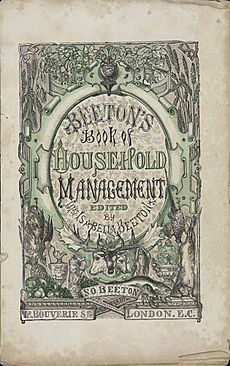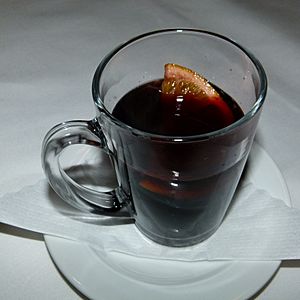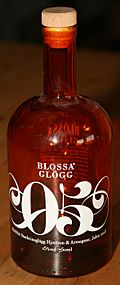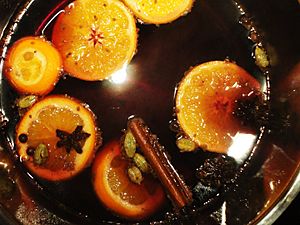Mulled wine facts for kids
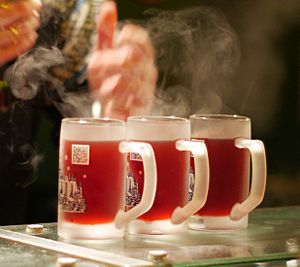
Mulled wine served in glass mugs at a Christmas market in Germany
|
|
| Alcohol by volume | 0–15% |
|---|---|
| Ingredients | Wine (red), spices and fruit |
| Variants | Glühwein, Glögg, and many others |
Mulled wine, also known as spiced wine, is a warm drink often made with red wine. It includes different mulling spices and sometimes raisins. People usually drink it hot or warm. It's a popular drink during winter, especially around Christmas. You can often find it at Christmas markets in Europe, especially in Germany. There are also versions made without alcohol.
Contents
Where Did Mulled Wine Come From?
People have been spicing and heating wine for a very long time! The first time we see this mentioned is in a play from ancient Rome, written around 200 BC. As the Romans traveled across Europe, they brought their wine and recipes with them. They shared these traditions all the way to the Rhine and Danube rivers and even near Scotland.
Later, in 1390, a medieval English cookbook called The Forme of Cury mentioned mulled wine. It talked about grinding spices like cinnamon, ginger, cloves, nutmeg, and cardamom. These spices were then mixed with red wine and sugar.
Mulled Wine in Britain
Mulled wine is very popular in the United Kingdom during Christmas. It's also enjoyed throughout the winter. People sometimes drink mulled cider, which is like mulled wine but made with apple cider. There's also mulled apple juice, which is a non-alcoholic choice.
Old Recipes for Mulled Wine
Over time, how mulled wine is made has changed. An old recipe from 1869 can be found in Mrs. Beeton's Book of Household Management. This book was very famous in Victorian times. It suggested boiling spices like cloves, nutmeg, and cinnamon in water first. Then, you would add wine and sugar and heat it up. The book said that port wine and claret (a type of red wine) were often used. It also mentioned using a special clean pot just for mulled wine.
Modern Mulled Wine in Britain
Today, there isn't just one way to make mulled wine in Britain. It often includes orange, lemon, cinnamon, nutmeg, star anise, cloves, cardamom, and ginger. Sometimes, people boil the spices in a sugar syrup first. Then, they add red wine and heat it. Some recipes also add brandy or ginger wine. For an easy way, you can even use a tea bag filled with spices! Mulled wine is usually served in small mugs, sometimes with an orange slice decorated with cloves.
Glühwein in German-Speaking Countries
Glühwein (pronounced "gloo-vine") means "smouldering wine" because of how warm it gets. It's very popular in countries where German is spoken, like Germany, and also in the Alsace region of France. It's a traditional drink during the Christmas holidays. At Christmas markets in Alsace, it's often the only alcoholic drink you can buy. The oldest known Glühwein cup is from around 1420!
Glühwein is usually made with red wine. It's heated and spiced with cinnamon sticks, cloves, star aniseed, orange, sugar, and sometimes vanilla. You can also get it mit Schuss (with a shot), which means a bit of rum or other strong alcohol is added. Sometimes, people use fruit wines, like blueberry or cherry wine, instead of grape wine. There's also a less common version made with white wine. For kids at Christmas markets, they offer Kinderpunsch, which is a non-alcoholic punch with similar spices.
Another fun version of Glühwein in Germany is Feuerzangenbowle. It uses the same recipe, but a sugarloaf soaked in rum is set on fire above the wine. The melting, burning sugar drips into the drink!
Glögg in Nordic Countries
Glögg (pronounced "gloog") is the name for mulled wine in countries like Sweden, Norway, Denmark, and Finland. It's a very popular drink at Christmas events.
You can buy glögg ready-made, or you can make it yourself. There are both alcoholic and non-alcoholic versions. Alcoholic glögg is made with red wine, sugar, and spices like cinnamon, cardamom, ginger, and cloves. Sometimes, stronger spirits like vodka or brandy are added. You can buy spice mixes for glögg in grocery stores. To make it, you mix the spices into the wine and heat it up.
Glögg is usually served with raisins, blanched almonds, and ginger biscuits (gingerbread cookies). It's a favorite hot drink during the Christmas season. In Sweden, it's often served with gingerbread and special sweet buns called lussebullar on December 13th, which is Saint Lucy's Day. In Denmark, people often eat æbleskiver (small pancake balls) with their gløgg.
Glögg recipes can be very different. Some use white wine, or sweet wines like Port. You can also make it without alcohol by using fruit juices instead of wine.
Mulled Wine Around the World
Mulled wine is enjoyed in many other countries too!
- In Croatia, Slovenia, and Serbia, it's called kuhano vino ("cooked wine"). It's made with red or white wine and spices like nutmeg, cloves, cinnamon, and orange zest.
- In Brazil, it's called vinho quente or quentão ("hot wine"). It's made with red wine, cinnamon sticks, and cloves. It's popular during the June festivals.
- In Bulgaria, it's greyano vino ("heated wine"). It uses red wine, honey, and black pepper. Sometimes apples or citrus fruits are added.
- In Chile, it's called candola or vino navega'o. It's a hot drink with red wine, orange peels, cinnamon sticks, cloves, and sugar.
- In the Czech Republic, it's svařené víno ('boiled wine').
- In France, it's vin chaud ('hot wine'). It usually has red wine, honey, cinnamon, and orange.
- In Hungary, it's forralt bor ('boiled wine'). It's made with local wines and spiced with cinnamon, sugar, and cloves.
- In Italy, especially in the north, it's vin brulé ('burnt wine').
- In the Netherlands and Belgium, it's known as bisschopswijn ('bishop's wine'). People drink it during the Sinterklaas holidays.
- In Poland, it's grzane wino ('heated wine'). They also have grzane piwo, which is mulled beer!
- In Russia and Ukraine, it's Glintvein, similar to the German Glühwein.
See also
 In Spanish: Vino caliente para niños
In Spanish: Vino caliente para niños


